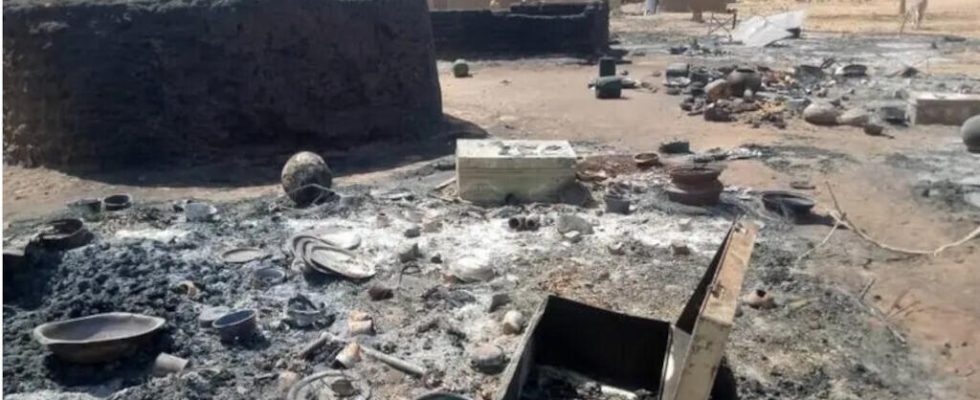It has been two years, this Wednesday, March 27, since the Moura massacre took place. For four days, the inhabitants of this village in the Mopti region, in central Mali, experienced hell. An anti-terrorist operation carried out jointly by the Malian army and the Wagner group left more than 500 dead, mainly civilians. Despite the authorities’ commitments, two years later, impunity is total.
5 mins
“ More than 500 dead », women raped, villagers tortured. The five Malian army helicopters arrived in Moura on a market day. The village was crowded. When they opened fire on the crowd, even before landing, the Malian soldiers and mercenaries from the Wagner group first killed “ twenty civilians and a dozen alleged members of Katiba Macina », from Jnim, linked to al-Qaedaaccording to a UN report published last year.
Then, for the next four days, Moura was the scene of horror. The United Nations published a particularly in-depth investigation last year. Many media and human rights organizations had also, from the first days, reported appalling testimonies. In total, more than 500 summary executions were denounced by theUN, villagers were forced to dig mass graves and bury the dead there, at least 58 women and young girls were raped or victims of sexual violence, sometimes collective. Several dozen people arrested in Moura were subsequently tortured.
The Malian army denounces accusations “ unfounded » intended for “ tarnish the image » of the Malian forces, and assures that 203 people were killed that day – and not 500 –, all “ terrorists “. An investigation was officially opened by Malian military justice two years ago.
To rereadMali: more than 500 people executed by the army and its auxiliaries in Moura in 2022, according to the UN
“Mali has failed in its obligations of justice and truth”
Ousmane Diallo, a researcher at Amnesty International in Dakar, was among the first to document the Moura massacre. In a report just published by Amnesty, he provides details on the bombing of Amasrakad, where civilians were again killed by the Malian army ten days ago. RFI revealed the tragedy. Ousmane Diallo also denounces the impunity from which the perpetrators of the Moura massacre still benefit. Interview.
RFI: On April 6, 2022, the Mopti military court announced the opening of an investigation and promised “ in-depth investigations “. Two years later, where are we?
Ousmane Diallo: Two years later, there is no progress. Witnesses have been hunted down over the past two years. Many human rights defenders who were involved in this affair had to flee into exile. The Malian state has failed in its obligations of justice and truth in relation to Moura, which is the deadliest incident since the start of the Malian crisis. To our knowledge, no official has been sanctioned in relation to Moura. There was no serious hearing for the victims. Above all, there were arrests and attempts to intimidate the victims and their parents. So two years later, despite the seriousness of this war crime, there is still no justice for Moura.
To hear you say, it’s even the opposite, no justice but rather a reversal of responsibilities with threats against the survivors?
This is what is even more shocking, because in the government’s narrative in relation to Moura, the witnesses and those who investigated were seen as trying to sabotage the military resurgence of the Malian army, so it was seen as an attempt at external interference. And in the speech, it is: “ Human rights are just an alibi to criticize Mali “, while there, in fact, we are talking about 500 deaths summarily executed, and I think it is important for Mali that the authorities sanction those responsible for what happened between March 27 and 31, 2022 .
In a study published this Tuesday by Amnesty, you document a new case of civilians killed by the Malian army. It was ten days ago, March 17, in Amasrakad, Gao region.
The Malian army killed thirteen people, including seven children, following a drone strike. Some time ago, it was Amasrakad, but there were allegations before: there was Ersane in November 2022, or just recently, the allegation of a strike against a village in the circle (the commune, Editor’s note) from Mondoro, to Douna, which also caused around ten victims. Drone strikes are intensifying, and the principle of distinction between civilians and military is rarely made. Above all, the populations who are victims of these blunders have no possibility of recourse at the national level.
But isn’t it difficult for the Malian army and Wagner, in their war against terrorism, to avoid killing civilians?
When blunders are repeated regularly, it is because we are not following a logic of protection of civilians. There are legitimate targets for Malian operations, whether armed groups or their logistics depot. But in Mali, at the moment, we are not in a logic where the principle of distinction between civilians and soldiers is made.
Read alsoMali: deadly jihadist attack near Sikasso, army blunder in Amasrakad near Gao
